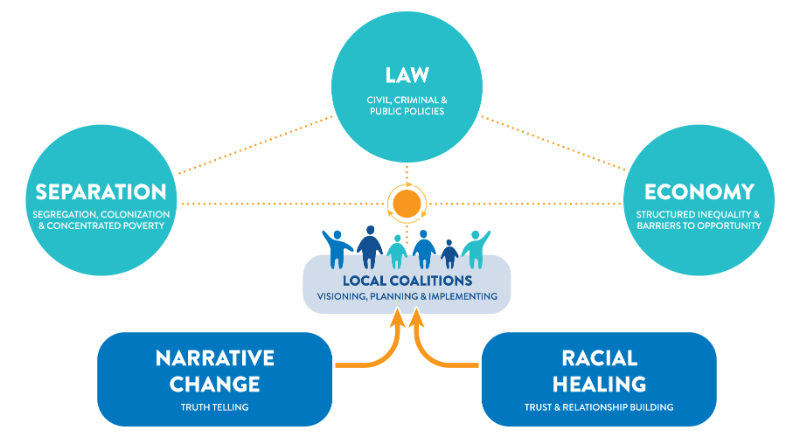
The TRHT framework helps communities heal and produce actionable change. From the beginning, TRHT was designed by the community and through collaboration. Community-led collaboration – that is cross-racial, intergenerational, and cross-sector – remains the centerpiece of all TRHT efforts.
The two foundational areas all TRHT communities address are:
-
Narrative change (truth-telling)
-
Racial healing (trust & relationship building)
Communities also choose to pursue work around one or all of the following pillars:
-
Separation (segregation, colonization, concentrated poverty)
-
Law
-
Economy
Narrative Change
False narratives hamper our ability to understand our world and relationships as they are, leading us to create and reinforce perceptions that are untrue. A more complete story needs to be presented in school curricula, news media, movies, television, radio, digital media, gaming platforms, cultural institutions, and in the personal histories told within families. This process influences our perspectives, perceptions, behaviors and interactions with one another so that we can more effectively create change.
Racial Healing and Relationship Building
Focusing on ways for all of us to heal from the wounds of the past, to build mutually respectful relationships across racial and ethnic lines that honor and value each person’s humanity, and to build trusting intergenerational and diverse community relationships that better reflect our common humanity.
Separation
Examining and finding ways to address segregation, colonization and concentrated poverty in neighborhoods to ultimately ensure equitable access to health, education and jobs.
Law
Reviewing discriminatory civil and criminal laws and the public policies that come from them and recommending solutions that will produce a just application of the law.
Economy
Studying structured inequality and barriers to economic opportunities and recommending approaches that can create an equitable society.